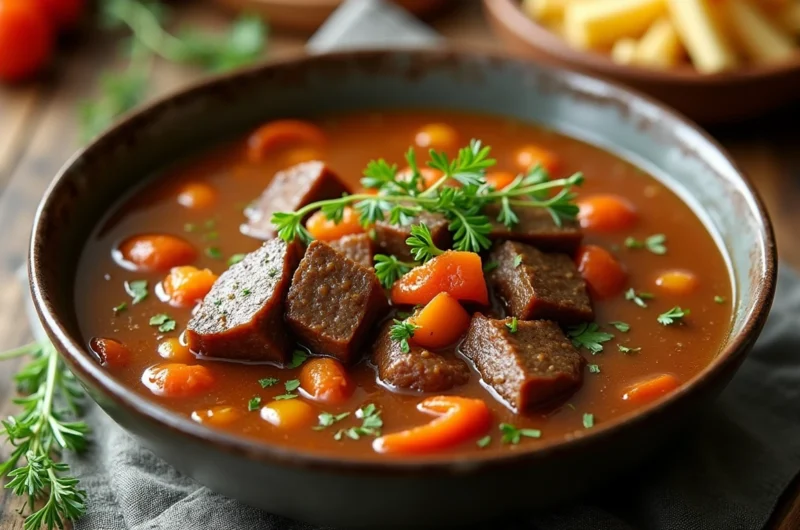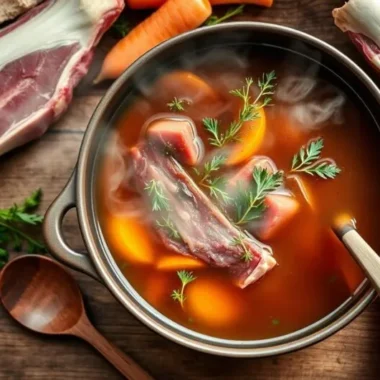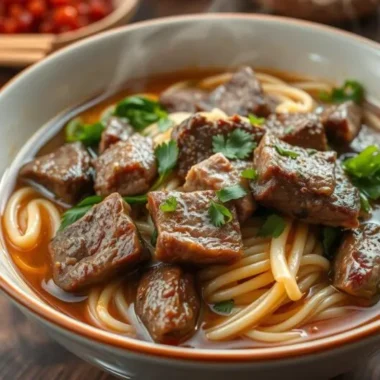Winter’s chill is here, and nothing warms the soul like a hot bowl of homemade soup. Beef bones are the secret to a comforting, nourishing soup. They simmer low and slow, turning into a rich, flavorful broth.
Growing up, my grandmother’s beef bone soup filled our house with comfort. The meat, vegetables, and broth were always perfect. Now, as a busy parent, I aim to make that magic in my kitchen. I’m excited to share this amazing recipe with you.
Table of Contents
Introduction to Soup from Beef Bones
Beef bone soup is a tasty and healthy dish that’s become very popular. It’s made by simmering beef bones, veggies, and spices to create a rich broth. Making this soup takes about five hours, but it’s worth it for its versatility and flavor.
The soup’s base is a homemade broth full of nutrients and gelatin. By cooking the bones for a long time, the broth gets all the flavor and nutrition it can. You can make it on the stovetop, in a slow cooker, or with an Instant Pot, making it easy for anyone to cook.
“Bone broth has been popular in the United States for several years and continues to maintain its popularity.”
Beef bone soup is great because you can change it up a lot. You can add different veggies, herbs, and spices to make it your own. Whether you like it simple or fancy, the beef bones and broth are the perfect base for a delicious meal.
Next, we’ll explore the health benefits, how to make it, and some creative ways to enjoy this nourishing soup. Get ready to learn how to make an amazing beef bone soup in your kitchen.
Benefits of Making Soup from Beef Bones
Beef bone soup is a great choice for a healthy meal. It’s full of nutritional value, has culinary advantages, and is cost-effective. This homemade broth is a real kitchen winner.
Nutritional Value
Beef bone soup is a collagen-rich broth full of vitamins, minerals, and amino acids. It’s anti-inflammatory, helping with fatigue and low mood. The broth has amino acids like glycine and glutamine, which are good for your gut and immune system.
It’s also rich in collagen, which is great for your skin and joints.
Culinary Advantages
Beef bone soup is not just healthy; it’s also delicious. Its deep, complex flavor can make any dish better. You can use it in stews, drink it on its own, or in other recipes. Its versatility is unmatched.
Cost-Effectiveness
Beef bone soup is also a smart choice for saving money. Ingredients like beef shanks and veggies are cheap. Plus, you can freeze it for later, making it a budget-friendly and convenient option.
Beef bone soup is a must-have in every kitchen. It’s nutritious, versatile, and affordable. It’s a true kitchen staple.
“I started drinking a cup of bone broth daily, and I noticed a significant improvement in my skin condition within a week. It’s become an essential part of my wellness routine.”
Choosing the Right Beef Bones
Choosing the right bones is key to a tasty beef bone soup. Beef knuckles, joints, neck, and straight bones are the best. They add a rich flavor and are full of collagen and amino acids.
Types of Bones to Use
- Beef knuckles: These joints are filled with collagen, contributing to a rich, gelatinous texture in the broth.
- Beef neck bones: The neck area is dense with connective tissue, which breaks down during simmering to release an array of beneficial nutrients.
- Beef marrow bones: The marrow inside these bones is a treasure trove of healthy fats, vitamins, and minerals, imparting a decadent flavor.
- Beef shank bones: Shanks contain a good amount of meat and marrow, making them an excellent choice for a hearty, nourishing broth.
Grass-Fed vs. Grain-Fed
Choosing grass-fed beef bones is a good idea. They have more omega-3s, vitamins, and minerals. This makes your broth more nutritious and flavorful.
Where to Buy Quality Bones
You can find quality bones at local butchers or online at places like Seven Sons. They offer a variety of bones from grass-fed cattle. Buying from trusted sources ensures your soup is both delicious and healthy.
Preparing the Ingredients
To make a delicious beef bone soup, start with the right ingredients. Choose 3.5 pounds of high-quality beef bones. These bones are the base for a tasty beef stock.
Add essential vegetables like 2 stalks of celery, 1 large onion, 1 medium leek, and a whole head of garlic. These will make your soup rich and flavorful.
Essential Vegetables
The vegetable preparation is key to a great soup. Use a mix of onions, carrots, celery, and leeks. They add sweetness, crunch, and aroma to the broth.
Herbs and Spices
Herbs and spices can make your soup even better. Bay leaves, parsley, and thyme add earthy, fragrant flavors. Season with salt and pepper to taste.
Additional Flavor Enhancers
- Garlic: Minced or crushed garlic adds a warm, pungent flavor enhancer to the soup.
- Apple Cider Vinegar: A splash of apple cider vinegar can lend a subtle tang and help balance the richness of the broth.
- Worcestershire Sauce: A few dashes of Worcestershire sauce contribute a savory, umami complexity to the soup.
By choosing and preparing these ingredients well, you’ll make a delicious beef bone soup. It’s sure to please your taste buds.
| Ingredient | Quantity |
|---|---|
| Beef Bones | 3.5 lbs |
| Celery | 2 stalks |
| Onion | 1 large |
| Leek | 1 medium |
| Garlic | 1 whole head |
| Bay Leaves | 2 |
| Parsley | 1 tbsp |
| Thyme | 1 tbsp |
| Salt | To taste |
| Black Pepper | To taste |
| Apple Cider Vinegar | 1 tbsp |
| Worcestershire Sauce | A few dashes |
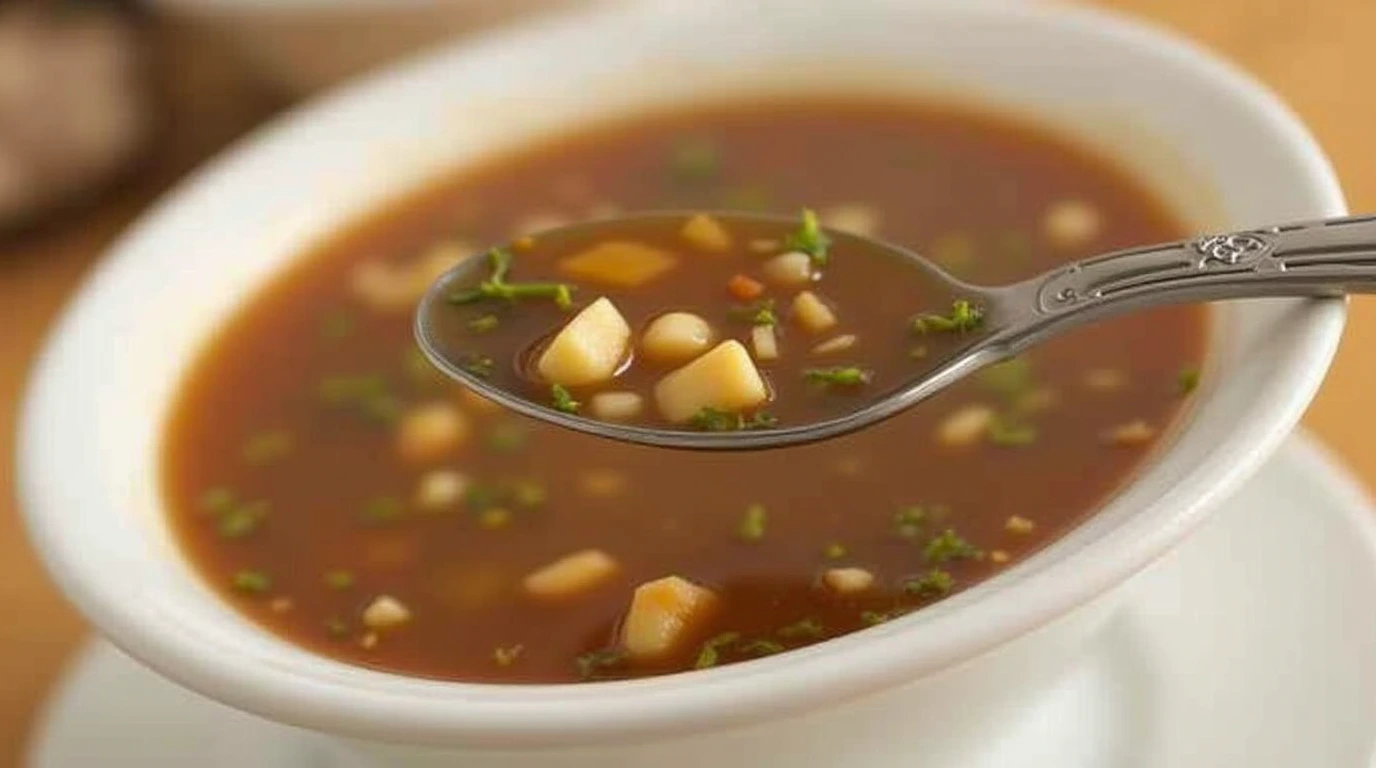
Cooking Methods for Beef Bone Soup
There are many ways to make delicious beef bone soup. You can use the stovetop, slow cooker, or Instant Pot. Each method has its own benefits, helping you create a tasty and healthy broth.
Stovetop Method
The stovetop method is a traditional way to make beef bone soup. First, roast the bones at 450°F for 40 minutes. This step adds a rich flavor to the bones.
Next, put the roasted bones in a big pot and cover them with water. Let the broth simmer on the stovetop for 3 to 12 hours. This long simmering time helps to extract the collagen from the bones.
While the broth is simmering, you can add vegetables like carrots, onions, and celery. These will make the soup even more flavorful.
Slow Cooker Method
The slow cooker is a great choice for making beef bone soup because it’s easy and hands-off. Start by roasting the bones at 450°F for 40 minutes, just like with the stovetop method.
Then, put the bones in a slow cooker and cover them with water. Set the slow cooker to low heat and let it simmer for about 18 hours. This long cooking time ensures that the bones release all their nutrients and flavors.
Instant Pot Method
The Instant Pot is a fast way to make beef bone soup. It’s not mentioned in the sources, but you can use it to cook the broth quickly. Start by roasting the bones at 450°F for 40 minutes.
Then, put the bones in the Instant Pot with water. Use the pressure cooking function to extract the flavors and nutrients from the bones quickly. This method is faster than the stovetop or slow cooker methods.
No matter which method you choose, using high-quality, roasted bones is key. Roasting the bones adds a deeper, more complex flavor to the broth.
The Importance of Bone Broth
Bone broth is packed with nutrients that boost your health. It’s made by simmering animal bones for a long time. This process extracts collagen, amino acids, and minerals.
Difference Between Broth and Stock
Bone broth and stock are not the same. Bone broth is simmered for 12-48 hours. This makes it rich in collagen and other nutrients. Stock, on the other hand, is made in 2-6 hours with meat, bones, and veggies.
How Bone Broth Supports Wellness
Bone broth is great for your health. It’s full of collagen, which is good for your skin, joints, and connective tissue. Drinking it can make your skin look better and help with digestion.
Common Uses for Bone Broth
- Sipping bone broth as a warm, nourishing beverage
- Using it as a base for soups, stews, and sauces
- Incorporating it into recipes like risottos, rice dishes, and sauces
- Enjoying it as a flavorful replacement for water or stock in cooking
- Blending it into smoothies or shakes for an extra nutritional boost
Bone broth is good for your health and can make your food taste better. It’s a great addition to your diet.
Straining and Storing the Soup
Once your beef bone soup is ready, it’s time to strain and store it. This keeps its flavor and nutrients intact. Straining removes solids and impurities, leaving a smooth broth.
Best Practices for Straining
To strain your beef bone soup, follow these simple steps:
- Place a fine-mesh strainer over a large bowl or container.
- Carefully ladle the hot soup into the strainer, allowing the broth to flow through while the solids, such as bones and vegetables, are left behind.
- Gently press on the solids with a spoon to extract as much flavorful broth as possible.
- Discard the strained solids or reserve them for other uses, such as feeding pets or adding to compost.
Proper Storage Techniques
After straining, your beef bone soup is ready for storage. To keep it fresh, follow these guidelines:
- Allow the soup to cool completely before transferring it to airtight containers or freezer-safe bags.
- Leave about an inch of headspace in each container to allow for expansion during freezing.
- Label the containers with the date and contents to keep track of their freshness.
- Refrigerate the soup for up to 7 days or freeze it for 3-5 months.
How Long Can It Be Stored?
Properly stored, your homemade beef bone soup can last a long time. It stays fresh in the fridge for up to 7 days. For longer storage, freeze it for 3-5 months. Cool the soup quickly in an ice bath before freezing to prevent bacterial growth.
“Straining and storing your beef bone soup properly is the key to enjoying its delicious flavor and reaping its numerous health benefits for weeks or even months to come.”
Enhancing the Flavor of Your Soup
Boosting the taste of your homemade beef bone soup is simple. Try adding different soup seasonings like thyme, oregano, or red pepper flakes. These can add depth and complexity. Also, a bit of flavor enhancers such as tomato paste or soy sauce can bring a nice acidity to balance the richness.
Adding soup garnishes can elevate your soup even more. Top it with crunchy croutons, fresh chives, parsley, or Parmesan cheese. For a stronger beef taste, mix in beef broth concentrate or beef base before adding salt.
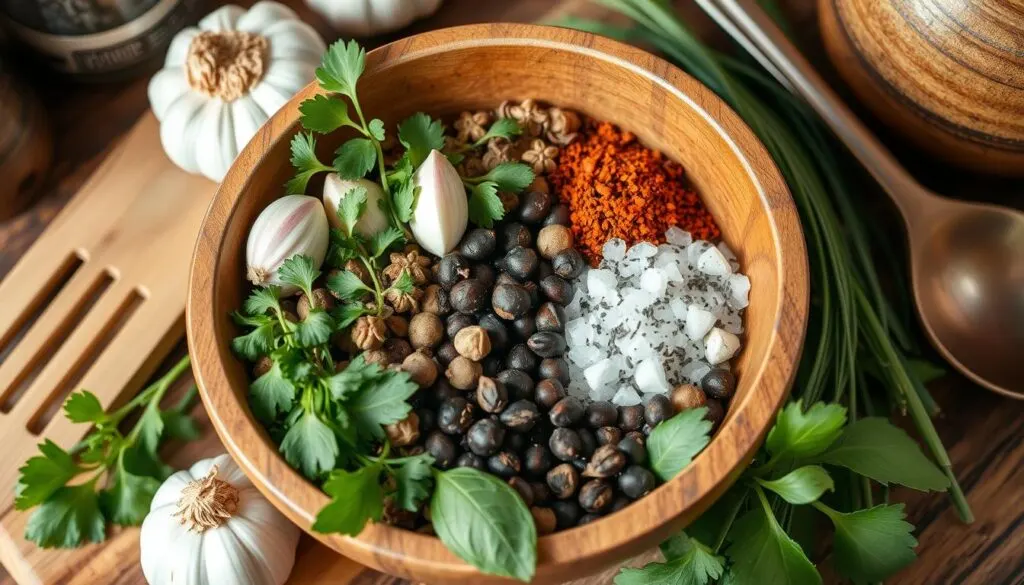
By trying out various seasonings, acidic ingredients, and garnishes, you can make a beef bone soup that’s truly delicious. This dish is versatile, so let your creativity run wild and make it your own.
Serving Suggestions for Beef Bone Soup
Enjoy your homemade beef bone soup hot. Serve it with crusty bread or flaky buttermilk biscuits. It’s great for cold winter days or when you’re not feeling well. The recipe makes about 7 quarts, so you can adjust the servings for your family and friends.
Ideal Pairings
Beef bone soup goes well with a fresh salad or a simple sandwich. The soup’s rich flavors match the crunch of a green salad. A grilled cheese or deli sandwich is a classic, comforting choice.
Serving Temperature
Serve the soup piping hot for the best taste. The long simmering process makes the broth rich and complex. Simmer it for up to 8 hours on low heat to get the most flavor.
Portion Sizes
- The recipe yields about 7 quarts of beef bone broth, enough for 12 people.
- Recommended portion size is 1-2 cups per person, depending on appetite and whether it’s a main dish or side.
- Leftover soup can be stored in the fridge for up to 7 days or frozen for 3-5 months, perfect for meal prep.
By serving your homemade beef bone soup hot, pairing it with complementary dishes, and adjusting the portion sizes, you can fully enjoy this nourishing and delicious meal.
Troubleshooting Common Issues
Cooking homemade beef bone soup can be rewarding, but you might face some challenges. Don’t worry, we’ve got you covered! We’ll tackle common issues and offer solutions to make your soup perfect every time.
Soup Too Greasy?
If your soup is too greasy, don’t worry. To fix it, refrigerate the soup overnight. This lets the fat solidify, making it easy to skim off the top. Use a spoon or ladle to remove the hardened fat before reheating and serving.
Flavor Too Bland?
If your soup lacks flavor, adding more seasonings can help. Try salt, pepper, garlic, or herbs. You can also add a beef base or bouillon to boost the umami. Adjust the seasoning slowly until it tastes right.
How to Fix Over-Salted Soup
Did you add too much salt? No worries! To fix it, add a peeled and diced potato. The potato will soak up the excess salt as it simmers. Or, you can dilute the soup with unsalted broth or water. Taste and adjust the seasoning slowly to get it just right.
With these tips, you’ll soon enjoy a delicious, flavorful, and perfectly seasoned beef bone soup. Happy cooking!
Creative Variations of Beef Bone Soup
Beef bone soup is a versatile dish that can be easily adapted to suit your taste preferences and dietary needs. You can add noodles or rice, introduce different proteins, or create vegetarian alternatives. The possibilities are endless when it comes to elevating this comforting classic.
Adding Noodles or Rice
To create a heartier meal, consider incorporating noodles or rice into your beef bone soup. Spaghetti or wide egg noodles can add texture and substance. Meanwhile, jasmine or basmati rice can transform the soup into a more substantial one-dish dinner.
Introducing Different Proteins
While the traditional beef bone soup features, well, beef bones, you can also experiment with other protein sources. Try adding cubed beef chuck or shredded chicken for a meatier soup experience. For a creamy variation, stir in coconut milk towards the end of the cooking process.
Vegetarian Alternatives
For those looking to enjoy the benefits of bone broth without the meat, there are plenty of vegetarian options. Substitute the beef bones with mushrooms, seaweed, or vegetables. Use vegetable stock instead of beef stock to create a nourishing, meat-free soup.
“Beef bone broth is an excellent source of hydration, providing fluids and electrolytes to replenish the body.”
No matter which variation you choose, the key to a delicious beef bone soup lies in the quality of the ingredients and the care taken during the cooking process. Experiment with different flavors and combinations to find the perfect recipe that suits your taste buds and dietary preferences.
Frequently Asked Questions (FAQs)
Preparing delicious soup from beef bones can raise a few common questions. Let’s tackle some of the most asked queries to help you get the best results.
How Long Should You Cook Soup from Beef Bones?
The cooking time for beef bone soup varies. Generally, simmer the bones for 3-12 hours on the stovetop. Or, up to 18 hours in a slow cooker. The longer you cook, the richer and more flavorful your soup will be.
Can I Use Frozen Bones?
Yes, you can use frozen beef bones for your soup. Remember, cooking time might be longer for frozen bones. It takes longer for them to release flavor and nutrients. Make sure to thaw the bones before adding them to your pot or slow cooker.
Is It Safe to Reheat Beef Bone Soup?
Yes, it’s safe to reheat beef bone soup. Just make sure it heats up to at least 165°F to kill bacteria. When reheating, only heat what you plan to eat. Reheating the whole batch can affect the soup’s quality and taste.
By keeping these questions in mind, you’ll enjoy delicious, nutritious beef bone soup at home. Try different cooking methods and ingredients to find your favorite recipe.
Conclusion: Enjoying Your Homemade Beef Bone Soup
Homemade beef bone soup is a nutritious, flavorful, and cost-effective meal. It’s easy to add to your cooking routine. You can try different ingredients and methods to make it your own.
Simmering the beef bones releases important nutrients like calcium, magnesium, and phosphorus. These nutrients offer many health benefits. Homemade beef bone soup is great for your gut health, immune system, or just a comforting meal.
With the right techniques and quality ingredients, you can make a delicious homemade broth. It’s perfect for many dishes. So, get creative, try new flavors, and enjoy the warmth of your homemade beef bone soup.
FAQ
How long should you cook soup from beef bones?
Can I use frozen bones?
Is it safe to reheat beef bone soup?
How can I enhance the flavor of my beef bone soup?
How can I reduce the greasiness of my beef bone soup?
What if my beef bone soup is too salty?
Can I freeze beef bone soup?
Source Links
- Old Fashioned Vegetable Beef Soup – https://2cookinmamas.com/homemade-vegetable-beef-soup/
- Nourishing Beef Bone Broth – https://www.raisinggenerationnourished.com/2014/02/nourishing-beef-bone-broth/
- Bone Broth: Benefits, How To Make and Nutrition – https://health.clevelandclinic.org/bone-broth-benefits
- Hearty Italian Beef Soup – https://www.theslowroasteditalian.com/hearty-beef-soup-recipe/
- Bone Marrow Soup with Beef Bones – A Heart Full of Love – https://aheartfulloflove.com/bone-marrow-soup-with-beef-bones/
- I Drank A Cup Of Bone Broth Every Day For A Week. Here’s How My Skin Changed – https://www.vogue.co.uk/article/bone-broth-benefits-health
- 5 benefits of Bone Broth & fun ways to use it! — Dahl Ranch – https://www.dahlranchmt.com/blog-recipes/5-health-benefits-of-bone-broth-and-2-fun-ways-to-use-it
- The Ultimate Guide to Beef Bones for Broth: Benefits and Recipes – https://www.farm2forkdelivery.ca/blogs/news/the-ultimate-guide-to-beef-bones-for-broth-benefits-and-recipes?srsltid=AfmBOoqsnV7DwY2saunKzd5JzbD78d6K5dG70-vIrLGALAqnja_1FzLw
- What are the Best Bones for Soup? – https://lightlyrecipes.com/what-are-the-best-bones-for-soup/
- Hearty Stovetop Vegetable Beef Soup With Potatoes Ready In 1 Hour – https://www.thespruceeats.com/hearty-old-fashioned-vegetable-beef-soup-3051395
- Classic Vegetable Beef Bone Soup from Scratch – https://sevensons.net/recipes/beef-bone-soup?srsltid=AfmBOoo_6OOD7uEHV9l3AJqB_rEJTT2YGHCImBrHb1lfTSQyARNoveDC
- Sopa de Hueso Recipe (Beef Bone Soup) – https://www.dominicancooking.com/sopa-res-beef-soup
- How to Make Multiple Batches of Broth From the Same Bones – Roots & Boots – https://rootsandboots.com/how-to-make-multiple-batches-of-broth-from-the-same-bones/
- Top 5 health benefits of bone broth – https://www.bbcgoodfood.com/health/nutrition/health-benefits-of-bone-broth
- Bone Broth: The Benefits and the Risks – https://zoe.com/learn/bone-broth
- Beef vs. Chicken Bone Broth: Which Broth Boosts You Best? – https://www.barebonesbroth.com/blogs/blog/beef-vs-chicken-bone-broth?srsltid=AfmBOorKoPdVjWcMfSNs2fTQPhqP8kWAu57EtolNWGvI7lla-vtKxwYF
- How to Make Beef Broth 3 Ways / Should I use a Slow-Cooker, Instant Pot or Stove Top Method? – Our Liberty House – https://www.ourlibertyhouse.com/blog/beef-broth-3-ways
- How to Make Bone Broth – https://thesurvivalmom.com/how-to-make-bone-broth/
- How to Add Richness to Beef Soup ? – https://recipesfreshly.com/how-to-add-richness-to-beef-soup/
- The Ultimate Guide to Beef Bones for Broth: Benefits and Recipes – https://www.farm2forkdelivery.ca/blogs/news/the-ultimate-guide-to-beef-bones-for-broth-benefits-and-recipes?srsltid=AfmBOoo5XtPxgSn8pDBYDCgwqucc22I8tYFDJoebL8ku_4-5b5__Kbot
- Classic Vegetable Beef Bone Soup from Scratch – https://sevensons.net/recipes/beef-bone-soup?srsltid=AfmBOorsZZ5hPa-SX0q46UYyOSPEv1WbrA4Ko4OEooEsEy7xWJ5RLvco
- Beef and Vegetable Bone Broth Soup Recipe – https://discover.grasslandbeef.com/blog/beef-and-vegetable-bone-broth-soup/
- Classic Vegetable Beef Bone Soup from Scratch – https://sevensons.net/recipes/beef-bone-soup?srsltid=AfmBOopT6ohPc4o3BmLAin8zjd5-gqF8G8Wj0UvxmeFYk-zkTamJJDGD
- Roasted Beef Bone Broth – Our Southern Charmed Life – https://oursoutherncharmedlife.com/roasted-beef-bone-broth/
- Stock, Broth and Frequently asked questions – Low Tox Life – https://www.lowtoxlife.com/stock-broth-and-frequently-asked-questions/
- How to Make Bone Broth and Avoid Rancid Fat — A Complete Broth Guide – https://eatbeautiful.net/how-make-bone-broth-avoid-rancid-fat/
- Everything You Need to Know About Soup Bones – https://lightlyrecipes.com/everything-you-need-to-know-about-soup-bones/
- The Ultimate Guide to Beef Bones for Broth: Benefits and Recipes – https://www.farm2forkdelivery.ca/blogs/news/the-ultimate-guide-to-beef-bones-for-broth-benefits-and-recipes?srsltid=AfmBOoqYh2CmtJYdYrFBOUidjHtcquZWVgTW-hElprGia22y0_17q2hh
- Bold and Spicy Caribbean Beef Noodle Soup Recipe Twist – https://www.justmaikacooking.com/recipes/bold-and-spicy-caribbean-beef-noodle-soup/
- What Is Bone Broth? | D’Arcy’s Meat Market – https://darcysmeats.ca/blogs/blog/bone-broth-faqs-what-is-bone-broth?srsltid=AfmBOoqmJ_kivswCQJrtl7qiihOswE2sHWlp28zkQpvxfR8IJ4wuOkQ1
- Beef Cutting Instructions FAQ — North Fork Packing Company – https://www.northforkpacking.com/faqs
- How to Make Beef Bone Broth – Simple Life Mom – https://simplelifemom.com/how-to-make-beef-bone-broth/
- Healthy & Nutritious Bone Broth Recipe For Older Adults — More Life Health – Seniors Health & Fitness – https://morelifehealth.com/articles/bone-broth
Did You Try This Recipe ?
There are no reviews yet. Be the first one to write one.

